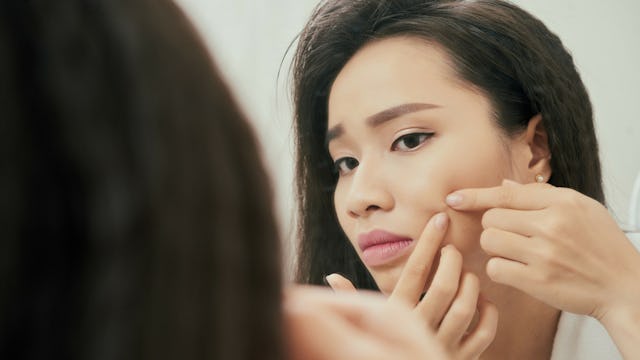Adult Acne: Battling Wrinkles And Pimples At The Same Time Totally Sucks

I finish washing my face and start applying my anti-aging moisturizer when my fingers run across a familiar sensation — a painful bump that I know from experience will be rearing its ugly (white) head in the next day or two.
I’m 42 years old, for crying out loud. I’ve been battling zits since I was a young teen. This decades-long annoyance had only been made more irritating by the fact that everything I’d read about acne as a teen said that I would outgrow it. I’ve gotten much more skilled at managing it, so that now it’s only single blemishes I’m whack-a-moling rather than full-on breakouts. But it still sucks.
Battling wrinkles and pimples at the same time seems like some kind of cruel joke, doesn’t it, Mother Nature?
If you’re in this boat, too, at least we’re not alone. Roughly 40–55% of the population is still dealing with acne well past adolescence, with adult women more likely to break out than men. Adult acne acts a bit differently than teen acne, as our skin takes on different qualities. Pimples in adults tend to concentrate around the chin, mouth, and jawline.
OMG, the jawline zits.
At this point, I feel like I get pimples on my neck almost as often as I do on my face. But my forehead and cheeks and nose still get the occasional blemish. So does my back.
Why?! Why are we forced to deal with tiny little Vesuviuses spewing forth from our bodies on a regular basis?
Here’s a fun fact: Nobody knows why exactly. We can put a man on the moon, but we can’t figure out why our skin keeps erupting on us. Come on, folks!
However, dermatologists do know some things and have some plausible theories. One big one is that most acne has to do with hormonal fluctuations. A new theory for adult acne is that different people have different balances of bacteria on their skin, some of which make some of us more susceptible to pimples. Some point to foods that trigger inflammatory responses in the body, which manifest as acne for some people. Others blame skin irritants in beauty products or other environmental factors.
All of those things may play differing roles in different people, but according to the International Dermal Institute, the main culprit of adult acne is chronic stress. Isn’t everything?
Continual, consistent stress causes hormones to spike, which increases oil production, which leads to more pimples. The IDI says that women today may be experiencing more adult breakouts because of the societal and personal expectations placed on our generation and the associated stress that comes along with it.
I think we can file that under “Well, duh.”
So what can be done? Personally, I feel like I’ve tried everything, with varying levels of success for various amounts of time. Sometimes I swear my acne is a sentient being with strategic problem-solving capabilities. Anytime I feel like I’m finally kicking it, my acne figures out my battle plan and skirts its way onto a new front. Just when I’m sure I’ve finally found a “cure” it makes a final-hour resurgence and the battle starts all over again.
In other words, acne is a tricky bastard.
I wish I had some miracle treatment to offer you, and I’m sure there will be loads of commenters who will evangelize about whatever skincare regimen is working for them (or that they’re selling — I see you, Rodan + Fields folks). Personally, I’ve found a retinol cream to be helpful in fighting both wrinkles and pimples at the same time. And if I don’t drink enough water and eat enough veggies, my skin suffers. But again, nothing has ever worked 100% for the long haul for me. If it was worse, I’d go see a dermatologist, but a handful of pimples every month isn’t enough for me to bother.
Maybe I should take advantage of my zit-prone skin and start my own pimple-popping Instagram or YouTube channel since that appears to be all the rage these days. Or maybe not.
Solidarity, adult acne sufferers. Here’s to hoping we’re not still in this boat together when we’re 70.
This article was originally published on